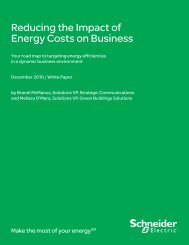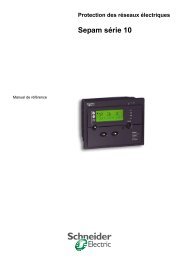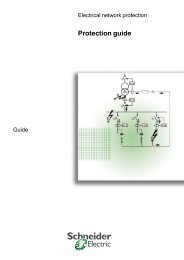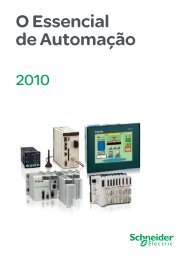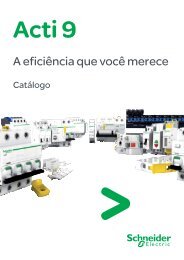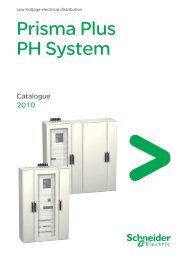Measurement and Management of Energy ... - Schneider Electric
Measurement and Management of Energy ... - Schneider Electric
Measurement and Management of Energy ... - Schneider Electric
You also want an ePaper? Increase the reach of your titles
YUMPU automatically turns print PDFs into web optimized ePapers that Google loves.
<strong>Measurement</strong> <strong>and</strong> <strong>Management</strong><br />
<strong>of</strong> <strong>Energy</strong> Performance<br />
in Office Buildings<br />
Guide for use by designers, operators <strong>and</strong><br />
users <strong>of</strong> Positive <strong>Energy</strong> <strong>of</strong>fice buildings.<br />
This is an English translation <strong>of</strong> a<br />
collaborative white paper written by<br />
the organisations involved in Bouygues<br />
Immobilier’s Positive <strong>Energy</strong> Consortium,<br />
in which <strong>Schneider</strong> <strong>Electric</strong> is an active<br />
participant.<br />
July 2010 / White Paper<br />
Make the most <strong>of</strong> your energy
Summary<br />
1.0 Introduction..............................................................................................3<br />
1.1 Observations............................................................................................3<br />
1.2 The challenges.........................................................................................3<br />
1.3 Levers <strong>and</strong> key factors..............................................................................3<br />
1.4 Use <strong>of</strong> this document...............................................................................4<br />
2.0 Needs analysis – design phase.................................................................5<br />
2.1 Description <strong>of</strong> the approach......................................................................5<br />
2.2 <strong>Energy</strong> <strong>and</strong> environmental performance consulting....................................5<br />
2.3 Legislative <strong>and</strong> regulatory context.............................................................6<br />
3.0 <strong>Measurement</strong> <strong>and</strong> management system design........................................9<br />
3.1 Goals.......................................................................................................9<br />
3.2 Outline <strong>of</strong> European st<strong>and</strong>ard EN 15232...................................................9<br />
3.3 Outline <strong>of</strong> European st<strong>and</strong>ard EN 16001...................................................10<br />
3.4 Areas <strong>of</strong> implementation...........................................................................11<br />
3.5 The structure <strong>of</strong> the measurement <strong>and</strong> management system.....................11<br />
3.6 <strong>Measurement</strong> <strong>and</strong> metering systems.........................................................13<br />
3.7 BMS architecture.....................................................................................15<br />
3.8 S<strong>of</strong>tware functions...................................................................................16<br />
3.9 Impact on network design........................................................................17<br />
4.0 Needs analysis - operational phase...........................................................18<br />
4.1 Approach to user behavior........................................................................18<br />
4.2 Operating rules........................................................................................19<br />
4.3 Organizing principles................................................................................20<br />
4.4 Dashboards.............................................................................................21<br />
4.5 Performance benchmarks........................................................................22<br />
4.6 Training....................................................................................................22<br />
5.0 Appendix.................................................................................................23<br />
5.1 BMS features according to st<strong>and</strong>ard EN 15232.........................................23<br />
5.2 Consumption calculation algorithms..........................................................27<br />
5.3 Performance benchmarks........................................................................28
White Paper<br />
1.0 Introduction<br />
1.1 Observations<br />
Positive energy building* projects need, more<br />
than ever, to employ new processes that facilitate<br />
better control <strong>of</strong> the implementation system <strong>and</strong> a<br />
better underst<strong>and</strong>ing <strong>of</strong> the needs <strong>and</strong> behaviors <strong>of</strong><br />
future users. The level <strong>of</strong> performance expected in<br />
these buildings requires the implementation <strong>of</strong> high<br />
technology systems to control energy usage <strong>and</strong><br />
still provide a satisfactory level <strong>of</strong> comfort.<br />
To date, construction projects have been driven by<br />
the traditional separate bidding <strong>and</strong> implementation<br />
<strong>of</strong> the various Building Services <strong>and</strong> Equipment<br />
(BSE) projects. Accordingly, it is <strong>of</strong>ten difficult to<br />
involve all <strong>of</strong> the stakeholders that are needed to<br />
achieve sustainable performance targets. The new<br />
regulations, which will come into effect shortly,<br />
encourage developers, investors, regulators <strong>and</strong><br />
building occupants to work together to identify the<br />
ideal energy configuration.<br />
1.2 The challenges<br />
The Positive <strong>Energy</strong> Consortium, through the<br />
expertise <strong>and</strong> international reputation <strong>of</strong> its<br />
members, has the ability to leverage opportunities<br />
provided through new technologies <strong>and</strong> to<br />
capitalize on the pressure from emerging<br />
regulations to develop processes that reduce<br />
energy consumption in <strong>of</strong>fice buildings. The<br />
following issues are <strong>of</strong> paramount importance:<br />
• To study <strong>and</strong> underst<strong>and</strong> the main components<br />
<strong>of</strong> the overall energy balance <strong>of</strong> the building as it<br />
is currently being used.<br />
• To analyze the existing roles <strong>and</strong> behavior <strong>of</strong> the<br />
various people involved with the building, so as<br />
to transform behavior to positively impact the<br />
energy <strong>and</strong> environment.<br />
• To engage operational stakeholders in a virtuous<br />
cycle by providing them with simple <strong>and</strong><br />
complete energy information that enables them<br />
to take positive actions appropriate to their role.<br />
1.3 Levers <strong>and</strong> key factors<br />
The working group has produced this white paper<br />
containing recommendations <strong>and</strong> suggestions for<br />
the most appropriate energy solutions, particularly<br />
in terms <strong>of</strong> the measurement <strong>and</strong> management <strong>of</strong><br />
energy performance. The primary topics are:<br />
• The definition <strong>of</strong> energy consumption<br />
optimization principles<br />
• The mapping <strong>and</strong> architecture <strong>of</strong> the technical<br />
systems <strong>of</strong> the building, including devices for<br />
measuring consumption, fine-tuning <strong>and</strong> precision<br />
• Project reorganization<br />
• New missions within companies through the role<br />
<strong>of</strong> the <strong>Energy</strong> <strong>and</strong> Environment Manager<br />
• Better control <strong>of</strong> performance through<br />
consumption benchmarks tailored to the new<br />
operating rules<br />
• An approach to encourage occupants to<br />
engage in more positive environmental habits<br />
This white paper addresses, as a priority, the<br />
stakeholders who are most directly involved in<br />
achieving the energy performance objectives for<br />
positive energy buildings.<br />
Developers <strong>and</strong> designers<br />
• A new design methodology that incorporates a<br />
technical engineering designer for energy <strong>and</strong><br />
environmental performance. It also reinforces<br />
agreement <strong>of</strong> all stakeholders through all<br />
phases, beginning with building design, through<br />
the BSE packages <strong>and</strong>, finally, the optimization<br />
<strong>of</strong> settings in the operational phase.<br />
• Recommendations on energy principles in<br />
anticipation <strong>of</strong> future energy regulation<br />
• Incorporation <strong>of</strong> tools <strong>and</strong> procedures needed to<br />
achieve performance objectives<br />
* Positive energy buildings consume less energy than they produce.<br />
<strong>Measurement</strong> <strong>and</strong> Managment <strong>of</strong> <strong>Energy</strong> Performance in Office Buildings | 3
White Paper<br />
Users (site managers, occupants <strong>and</strong> energy<br />
managers):<br />
• Raising awareness <strong>of</strong> energy performance.<br />
• Developing stakeholder engagement (behavioral<br />
change, usage scenarios, etc.)<br />
• Definition <strong>of</strong> the tools available to measure<br />
consumption, identify slippage <strong>and</strong> provide<br />
recommendations for action.<br />
Service providers (operational):<br />
• Essential involvement for the implementation<br />
<strong>of</strong> benchmarks which include contractual<br />
performance objectives<br />
• Tools <strong>and</strong> control panels to aid management<br />
• An administrative process required to achieve<br />
performance objectives<br />
1.4 Use <strong>of</strong> this document<br />
This white paper should be read as a design<br />
guide to develop positive energy buildings <strong>and</strong><br />
as an operational guide for facilities, equipment<br />
<strong>and</strong> use. Incorporating new processes for a wider<br />
range <strong>of</strong> stakeholders, it complements the existing<br />
<strong>and</strong> future regulations, recommendations <strong>and</strong><br />
labels, while providing perspective for innovative<br />
technological development.<br />
There will be massive advancement <strong>of</strong> energy<br />
efficiency activity between 2010 <strong>and</strong> 2020. The<br />
advancement will include the implementation <strong>of</strong><br />
solutions developed in positive energy buildings<br />
that are linked to a project management<br />
approach that is better suited to new build or<br />
refurbishment projects. Operating <strong>and</strong> service<br />
providers will be increasingly involved in attaining<br />
performance objectives, thanks to contractual<br />
benchmarks for energy consumption. Finally,<br />
the energy performance <strong>of</strong> buildings implies de<br />
facto management <strong>of</strong> renewable energy which<br />
contributes implicitly to a reduction in greenhouse<br />
gas emissions.<br />
<strong>Measurement</strong> <strong>and</strong> Managment <strong>of</strong> <strong>Energy</strong> Performance in Office Buildings | 4
White Paper<br />
2.0 Needs analysis – design phase<br />
2.1 Description <strong>of</strong> the<br />
approach<br />
Stakeholders should include devices to measure<br />
<strong>and</strong> manage the energy performance <strong>of</strong> buildings<br />
as part <strong>of</strong> a comprehensive approach during<br />
the design phase <strong>of</strong> construction projects. This<br />
approach involves directly, or indirectly, a range <strong>of</strong><br />
stakeholders <strong>and</strong> is based on:<br />
• Operational programs<br />
• Upstream structural design <strong>and</strong> technical solutions<br />
• <strong>Management</strong> implementation<br />
• Definition <strong>of</strong> the appropriate tools (Building <strong>and</strong><br />
<strong>Energy</strong> <strong>Management</strong> Systems (BEMS), analysis<br />
s<strong>of</strong>tware, instrumentation, etc.)<br />
• Calculation <strong>of</strong> an energy performance<br />
evaluation baseline<br />
The direct actors or stakeholders in the<br />
approach are:<br />
• The building manager<br />
• The building operator<br />
• The building occupants<br />
The actors involved in a preliminary approach are:<br />
• The building contractors<br />
• The project manager<br />
• The local authority representatives<br />
2.2 <strong>Energy</strong> <strong>and</strong> environmental<br />
performance consulting<br />
Today, energy <strong>and</strong> environmental concerns are<br />
issues that cut across wide range <strong>of</strong> trades <strong>and</strong><br />
specialty areas in the construction field.<br />
Schematic Representation <strong>of</strong> the Mission <strong>of</strong> the <strong>Energy</strong> <strong>and</strong><br />
Environmental Performance Consultant<br />
<strong>Measurement</strong> <strong>and</strong> Managment <strong>of</strong> <strong>Energy</strong> Performance in Office Buildings | 5
White Paper<br />
Accordingly, it is necessary to identify a new design<br />
approach that we will call “energy <strong>and</strong> environment<br />
consulting”, whose focus will be:<br />
Project planning <strong>and</strong> outline phase<br />
• Define the objectives <strong>and</strong> overall project<br />
principles from the energy <strong>and</strong> environment<br />
perspective (notably energy, zoning, network<br />
<strong>and</strong> metering architecture).<br />
• Define building occupation principles.<br />
• Calculate provisional energy consumption for<br />
each use to provide a reference for the first year<br />
<strong>of</strong> operation.<br />
• Produce the notes, documents <strong>and</strong> supporting<br />
information that is required for desired<br />
environmental certification.<br />
Design phase<br />
• Design the BEMS <strong>and</strong> coordinate the<br />
specifications <strong>of</strong> the other BSE packages to<br />
ensure consistency with the objectives.<br />
• Define the implementation procedures so that<br />
they are under a process <strong>of</strong> continuous control.<br />
• Define the procedure for acceptance <strong>of</strong> the work.<br />
Implementation phase<br />
• Acquire energy approval rating for the plans,<br />
technical specifications <strong>and</strong> modifications in order<br />
to validate compliance with energy balance.<br />
• Provide ongoing monitoring <strong>of</strong> implementation<br />
<strong>and</strong> control procedures.<br />
2.3 Legislative <strong>and</strong><br />
regulatory context<br />
Most developed countries have st<strong>and</strong>ards <strong>and</strong><br />
regulations in place for energy consumption <strong>and</strong><br />
greenhouse gas emissions. These are the result <strong>of</strong><br />
two major factors:<br />
1. The increase in the temperature <strong>of</strong> the surface<br />
<strong>of</strong> the earth, which is the result <strong>of</strong> emissions <strong>of</strong><br />
greenhouse gases<br />
2. The dwindling reserves <strong>of</strong> fossil fuels <strong>and</strong> the<br />
inevitable increase in energy prices<br />
At the global level, the Kyoto Protocol set an<br />
objective <strong>of</strong> an 8% total reduction in greenhouse<br />
gases, as compared to 1990 levels, the years<br />
2008 – 2012. An example <strong>of</strong> the implementation in<br />
France is shown.<br />
<strong>Measurement</strong> <strong>and</strong> Managment <strong>of</strong> <strong>Energy</strong> Performance in Office Buildings | 6
White Paper<br />
Chart Summarizing World Regulatory Developments<br />
Parallel to this, <strong>and</strong> in support <strong>of</strong> the Kyoto<br />
Protocol, many countries have developed an<br />
environmental certification scheme for the<br />
construction <strong>and</strong> management <strong>of</strong> buildings.<br />
• BREEAM ® (Building Research Establishment<br />
Environmental Assessment Method) has<br />
been in the United Kingdom since 1990. This<br />
approach is based on an analysis <strong>of</strong> the costs<br />
for environmental measures.<br />
• CASBEE ® (Comprehensive Assessment<br />
for Building Environmental Efficiency) was<br />
introduced in Japan in 2001. This benchmark is<br />
not limited to environmental requirements; it also<br />
covers energy, resources <strong>and</strong> materials.<br />
• LEED ® (Leadership in <strong>Energy</strong> <strong>and</strong> Environmental<br />
Design) was introduced in the United States<br />
in 1999. The most commonly used approach,<br />
LEED, enables building <strong>and</strong> renovation practices<br />
to be improved <strong>and</strong> is also an economic<br />
approach.<br />
• MINERGIE ® , introduced in Switzerl<strong>and</strong> in 1998,<br />
identifies new <strong>and</strong> refurbished buildings that<br />
meet specific energy consumption levels.<br />
All <strong>of</strong> these certifications are specifically directed at<br />
improving environmental quality.<br />
In France, today, all new construction must, at<br />
a minimum, meet the requirements <strong>of</strong> RT 2005<br />
(French Thermal Regulations). RT 2005 sets<br />
minimum quality st<strong>and</strong>ards for all components <strong>and</strong><br />
limits overall primary energy consumption per m²/<br />
year: CPE benchmark (CPE = Consumption in<br />
primary energy equivalence).<br />
RT 2012, currently being drafted, will impose a<br />
CPE benchmark reduction <strong>of</strong> around 20% so that<br />
by 2020 the following st<strong>and</strong>ards are reached:<br />
• BBC: low consumption building (Bâtiment<br />
Basse Consommation) with an objective <strong>of</strong> CPE<br />
benchmark = 50 kWhPE/m²/year in 2012.<br />
• BEPOS: Positive energy building (Bâtiment à<br />
Energie POSitive), projected for 2020.<br />
<strong>Measurement</strong> <strong>and</strong> Managment <strong>of</strong> <strong>Energy</strong> Performance in Office Buildings | 7
White Paper<br />
Current objectives are:<br />
• For 2020, a reduction <strong>of</strong> 20% in energy<br />
consumption <strong>and</strong> greenhouse gas emissions<br />
• For 2050: a reduction in greenhouse gas<br />
emissions by a factor <strong>of</strong> 4<br />
Health targets<br />
• Target 12 – Healthy spaces<br />
• Target 13 – Healthy air quality<br />
• Target 14 – Healthy water quality<br />
HQE ® Association (High Quality Environment)<br />
This legal context for energy performance could<br />
also include the approach <strong>of</strong> the HQE® Association<br />
(High Quality Environment) which has devised<br />
benchmarks for the Environmental <strong>Management</strong><br />
System. These benchmarks, combined with the<br />
explicit definition <strong>of</strong> Environmental Quality targets,<br />
guide building contractors in the implementation<br />
<strong>of</strong> an HQE approach, both operationally <strong>and</strong><br />
descriptively, for environmental management. It<br />
also has the goal <strong>of</strong> facilitating the establishment <strong>of</strong><br />
a certification system.<br />
This approach includes 14 targets for QEB<br />
(Environmental Quality <strong>of</strong> Buildings):<br />
Eco-construction targets<br />
In all cases, n°4 “energy management” must be at<br />
high performance or very high performance levels<br />
to comply with current regulations. This target is<br />
the focus <strong>of</strong> this guide.<br />
Within the framework <strong>of</strong> the current approach, the<br />
building must, at a minimum, qualify for BBC or<br />
BEPOS. Achieving this objective necessarily means<br />
choosing technical solutions <strong>and</strong> equipment that<br />
are linked to the building design in order to:<br />
• Meet minimum quality st<strong>and</strong>ards for all components<br />
• Guarantee overall consumption lower than the<br />
CPE benchmark (RT 2012)<br />
• Target 1 – A harmonious relationship between<br />
the building <strong>and</strong> its immediate environment<br />
• Target 2 – Integrated choice <strong>of</strong> construction<br />
products, systems <strong>and</strong> processes<br />
• Target 3 – Low noise site<br />
Eco-management targets<br />
• Target 4 – <strong>Energy</strong> management<br />
• Target 5 – Water management<br />
• Target 6 – Waste management<br />
• Target 7 – Servicing <strong>and</strong> maintenance<br />
management<br />
Comfort targets<br />
• Target 8 – Hygrothermal comfort<br />
• Target 9 – Acoustic comfort<br />
• Target 10 – Visual comfort<br />
• Target 11 – Olfactory comfort<br />
<strong>Measurement</strong> <strong>and</strong> Managment <strong>of</strong> <strong>Energy</strong> Performance in Office Buildings | 8
White Paper<br />
3.0 <strong>Measurement</strong> <strong>and</strong> management<br />
system design<br />
In order to measure <strong>and</strong> manage a building’s<br />
energy performance, it is necessary to implement<br />
a “<strong>Measurement</strong> <strong>and</strong> <strong>Management</strong> System” that<br />
goes beyond the traditional framework <strong>of</strong> Building<br />
<strong>Management</strong> System (BMS). Naturally, the system’s<br />
specifications, in line with its objectives, have an<br />
impact on the design <strong>of</strong> energy <strong>and</strong> fluid networks.<br />
3.1 Goals<br />
The goal <strong>of</strong> the measurement <strong>and</strong> management<br />
system is to provide the building stakeholders<br />
with the tools necessary to maintain <strong>and</strong> improve<br />
energy performance in <strong>of</strong>fice buildings. This requires<br />
us to address the complex problem <strong>of</strong> balancing<br />
the reduction <strong>of</strong> operating costs while ensuring<br />
continuity <strong>of</strong> services <strong>and</strong> the comfort <strong>of</strong> the<br />
building’s occupants, all at a minimum investment.<br />
Our goal, then, is to describe an energy<br />
management solution that protects the interests<br />
<strong>of</strong> all involved. In order to meet this objective, the<br />
measurement <strong>and</strong> management system must have<br />
the following characteristics <strong>and</strong> functions:<br />
• Realistic: to reflect the building’s actual<br />
energy performance<br />
• Durable: to run smoothly, <strong>and</strong> without<br />
interruption, throughout the building’s useful life<br />
• Efficient: to allow all parties to underst<strong>and</strong>, take<br />
appropriate actions <strong>and</strong> share responsibilities<br />
• User-friendly: to share knowledge effectively<br />
among all the stakeholders <strong>and</strong> to deliver only<br />
that information which is relevant to each person<br />
in a user-friendly format, exactly where <strong>and</strong><br />
when it is needed.<br />
• Flexible: to adapt to changing uses (i.e.,<br />
changing space allocation), including rented<br />
spaces <strong>and</strong> their occupants.<br />
• Affordable: to reduce operating costs<br />
throughout the building’s useful life, while<br />
minimizing investment costs.<br />
• Reliable: to measure <strong>and</strong> record actual<br />
consumption, <strong>and</strong> provide accurate data without<br />
errors or omissions.<br />
• Secure: to protect data, control <strong>of</strong> access rights<br />
<strong>and</strong> access tracking management.<br />
• Open: to be capable <strong>of</strong> importing (e.g.,<br />
degree-days) <strong>and</strong> exporting (e.g., multi-site<br />
comparisons) data over the Internet <strong>and</strong><br />
facilitate remote management <strong>and</strong> supervision.<br />
• Powerful: to be capable <strong>of</strong> simulating<br />
the impact <strong>of</strong> a single modification <strong>of</strong> the<br />
operating parameters on the building’s energy<br />
performance as a whole.<br />
3.2 Outline <strong>of</strong> European<br />
st<strong>and</strong>ard EN 15232<br />
New regulations concerning the management <strong>of</strong><br />
energy efficiency <strong>and</strong> environmental quality are<br />
in line with previous st<strong>and</strong>ards <strong>and</strong> represent a<br />
logical progression towards established targets. EN<br />
15232 establishes the conventions <strong>and</strong> methods<br />
used to estimate the effect <strong>of</strong> control automation<br />
systems <strong>and</strong> BMS on a building’s energy needs<br />
<strong>and</strong> performance.<br />
Scope <strong>of</strong> application<br />
The current European st<strong>and</strong>ard includes:<br />
• A structured listing <strong>of</strong> the control automation<br />
<strong>and</strong> BMS functions which impact a building’s<br />
energy performance<br />
• A method for defining the minimum<br />
specifications applicable to buildings <strong>of</strong> varying<br />
complexity with regard to automation control<br />
<strong>and</strong> BMS functions<br />
• A way <strong>of</strong> estimating energy-saving factors which<br />
can be used in conjunction with a building’s<br />
energy evaluation<br />
General information<br />
Effective building automation, control systems <strong>and</strong><br />
equipment ensure proper regulation <strong>of</strong> devices<br />
for heating, ventilation, cooling, water heating<br />
<strong>and</strong> lighting. They also increase operational<br />
performance <strong>and</strong> energy efficiency. In order to<br />
avoid unnecessary energy consumption <strong>and</strong> CO2<br />
emissions, various subroutines <strong>and</strong> complex,<br />
integrated functions can be configured based on a<br />
building’s actual usage <strong>and</strong> according to its users’<br />
real needs.<br />
<strong>Measurement</strong> <strong>and</strong> Managment <strong>of</strong> <strong>Energy</strong> Performance in Office Buildings | 9
White Paper<br />
The BMS functions provide useful information<br />
regarding operations, maintenance <strong>and</strong> building<br />
management. This information is particularly<br />
applicable to energy management, including<br />
functions for analyzing trends, activation warnings<br />
<strong>and</strong> unnecessary energy consumption diagnostics.<br />
<strong>Energy</strong> management is a requirement for<br />
regulating, monitoring, optimizing <strong>and</strong> determining<br />
a building’s energy performance.<br />
BMS effectiveness grades<br />
Functions that play a role in a building’s energy<br />
performance are divided into three groups:<br />
• Auto-regulated functions<br />
• Building automation functions<br />
• The building’s technical management functions<br />
These functions are divided into four different<br />
BMS effectiveness grades (A, B, C <strong>and</strong> D) for both<br />
residential <strong>and</strong> non-residential buildings.<br />
• Grade D means that the building’s systems<br />
yield poor energy efficiency. Buildings equipped<br />
with systems <strong>of</strong> this type should be brought up<br />
to st<strong>and</strong>ard. New buildings must not be built to<br />
Grade D st<strong>and</strong>ard.<br />
• Grade C means that a building’s BMS is in line<br />
with current st<strong>and</strong>ards.<br />
• Grade B means that a building’s BMS is in line<br />
with st<strong>and</strong>ard <strong>and</strong> advanced systems.<br />
• Grade A means that a building’s BMS yields a<br />
high level <strong>of</strong> energy performance.<br />
• Check: monitor <strong>and</strong> evaluate these processes<br />
in line with the organization’s energy policy,<br />
goals, targets, legal obligations <strong>and</strong> any other<br />
requirements, <strong>and</strong> report on the results.<br />
• Act: improve the energy management<br />
system’s performance on an ongoing basis by<br />
undertaking the necessary actions.<br />
The adoption <strong>of</strong> this methodology contributes to<br />
a process <strong>of</strong> continued improvement <strong>and</strong> results<br />
in more efficient energy consumption. It also<br />
encourages an organization to begin initiatives to<br />
monitor <strong>and</strong> analyze energy use. This methodology<br />
is intended to help any organization, irrespective <strong>of</strong><br />
its size or industry, to develop a thorough energy<br />
management approach <strong>and</strong> increase its energy<br />
efficiency. This European st<strong>and</strong>ard is the inspiration<br />
for the future International st<strong>and</strong>ard ISO 50001<br />
which goes into effect by the end <strong>of</strong> 2010.<br />
Drawing upon the competencies <strong>of</strong> an <strong>Energy</strong> <strong>and</strong><br />
Environment Manager (see paragraph 4.3), a program<br />
for the measurement <strong>and</strong> management <strong>of</strong> energy<br />
performance is to be developed based on an energy<br />
metering plan <strong>and</strong> the consumption benchmark.<br />
As this st<strong>and</strong>ard is <strong>of</strong>ficial, its contents are reliable<br />
<strong>and</strong> can be used as a reference.<br />
(Refer to functionality definitions in Appendix 5.1)<br />
3.3 Outline <strong>of</strong> European<br />
st<strong>and</strong>ard EN 16001<br />
Published in July 2009, as a supplement to EN 15232,<br />
this st<strong>and</strong>ard is based on the so-called Plan-Do-<br />
Check-Act (PDCA) methodology, briefly defined below.<br />
• Plan: establish the goals <strong>and</strong> processes<br />
necessary to obtain the results required<br />
according to the organization’s energy policy.<br />
• Do: implement these processes.<br />
<strong>Measurement</strong> <strong>and</strong> Managment <strong>of</strong> <strong>Energy</strong> Performance in Office Buildings | 10
White Paper<br />
3.4 Areas <strong>of</strong> implementation<br />
The proposed technical solution makes it possible<br />
to manage:<br />
• All energy: includes energy produced <strong>and</strong><br />
energy consumed<br />
• All energy usage: heating, ventilation, water<br />
heating, lighting, <strong>of</strong>fice appliances, etc.<br />
• All <strong>of</strong> a building’s space (both common areas<br />
<strong>and</strong> rented space)<br />
• Actions in the operational phase.<br />
• All equipment that generates or<br />
consumes energy<br />
3.5 The structure <strong>of</strong><br />
the measurement <strong>and</strong><br />
management system<br />
The first stage in the design <strong>of</strong> the measurement<br />
<strong>and</strong> management system consists <strong>of</strong> breaking<br />
down the building into areas <strong>of</strong> similar use.<br />
In order to ensure accurate measurement <strong>and</strong><br />
management as well as to maintain flexibility for<br />
modifications, each <strong>of</strong>fice area is divided into<br />
modules, the width <strong>of</strong> which is a multiple <strong>of</strong> the<br />
facade’s modular grid (generally 1.35 m).<br />
The second stage consists <strong>of</strong>:<br />
• Defining the measurement <strong>and</strong> reporting<br />
functions (i.e., dashboard) as well as the users.<br />
• Defining the management functions.<br />
• Allocating these functions according to their<br />
scope <strong>of</strong> application within the building.<br />
This approach allows us to specify the functional<br />
applications <strong>of</strong> an <strong>of</strong>fice building, effectively<br />
providing a framework within which we can:<br />
• Allocate corresponding instructions regarding<br />
temperature <strong>and</strong> scheduled use to each<br />
individual space.<br />
• Use Heating, Ventilation <strong>and</strong> Air Conditioning<br />
(HVAC) systems only when needed.<br />
• Divide energy costs between tenants fairly.<br />
• Define <strong>and</strong> monitor the energy performance plan<br />
for each individual tenant.<br />
The third stage consists <strong>of</strong> defining the interfaces<br />
between the measurement <strong>and</strong> management<br />
system <strong>and</strong> other technical systems related to<br />
energy <strong>and</strong> environmental performance.<br />
Internal equipment <strong>and</strong> appliances include:<br />
• Hardware (telephones <strong>and</strong> IT) powered by<br />
Ethernet (Power Over Internet). For example,<br />
providing power to IP telephony based on each<br />
<strong>Measurement</strong> <strong>and</strong> Managment <strong>of</strong> <strong>Energy</strong> Performance in Office Buildings | 11
White Paper<br />
location’s actual use<br />
• Office equipment so we can compile data on<br />
energy consumption to effectively monitor the<br />
total consumption <strong>of</strong> an operating <strong>of</strong>fice<br />
• Systems for the reservation <strong>of</strong> meeting rooms, or<br />
<strong>of</strong>fices in the case <strong>of</strong> job-sharing, in order to link the<br />
use <strong>of</strong> HVAC systems to their actual hours <strong>of</strong> usage<br />
Other functions which extend beyond a<br />
single building:<br />
• Tools used to record total energy <strong>and</strong><br />
environmental data for a larger complex. These<br />
tools are increasingly necessary as companies<br />
seek to manage CO 2 consumption <strong>and</strong> emissions.<br />
• Remote operation s<strong>of</strong>tware<br />
• Asset management tools used by real estate<br />
management pr<strong>of</strong>essionals<br />
<strong>Measurement</strong> <strong>and</strong> Managment <strong>of</strong> <strong>Energy</strong> Performance in Office Buildings | 12
White Paper<br />
3.6 <strong>Measurement</strong> <strong>and</strong><br />
metering systems<br />
The measurement infrastructure is established<br />
by mapping a building’s energy consumption<br />
<strong>and</strong> usage. It enables analysis at the individual<br />
<strong>of</strong>fice level, as well as individual-rented space,<br />
by actual usage. <strong>Measurement</strong> is based on an<br />
energy consumption tree diagram compiled from<br />
the building’s energy breakdown. This mapping is<br />
carried out in two successive phases.<br />
Physical areas: Areas corresponding to distinct,<br />
homogeneous activities which consume a<br />
significant amount <strong>of</strong> energy. For example:<br />
• The exterior<br />
• Parking areas<br />
• Staff canteen<br />
• Common areas<br />
• Rented spaces<br />
• Specific, shared services (child care center, copy<br />
center, etc.)<br />
Every area should be taken into account during<br />
design so that energy can be measured across the<br />
entire rentable area. If a given area is greater than<br />
400 m², a further, more detailed, breakdown may<br />
be needed (e.g. by floor, individual space, etc.).<br />
Functional usage: as consumed by major systems<br />
<strong>and</strong> divided according to physical areas. For example:<br />
• Heating<br />
• Cooling<br />
• Ventilation<br />
• Hot water heating<br />
• Lighting<br />
• Office automation<br />
You should define the measuring points necessary for<br />
the management <strong>of</strong> the building throughout its useful<br />
life from the outset. The number <strong>of</strong> measuring points<br />
determines the management system’s performance.<br />
Corresponding devices may be installed either when<br />
the building is placed into service or later. It is important<br />
to take installation <strong>and</strong> connection into consideration<br />
during the design <strong>of</strong> the BSE packages in order to<br />
minimize installation costs <strong>and</strong> inconveniences.<br />
All metering equipment is integrated into the building’s<br />
technical installations from the outset, in order to<br />
eliminate the need for temporary installations. Manual<br />
readings are kept to a strict minimum; therefore data<br />
is collected from measuring points automatically.<br />
The optimal technology to be used at each metering<br />
point is decided on a case-by-case basis, taking<br />
into account the amount <strong>of</strong> energy in question,<br />
technical feasibility, initial installation costs <strong>and</strong><br />
ongoing operating costs.<br />
<strong>Measurement</strong> <strong>and</strong> Managment <strong>of</strong> <strong>Energy</strong> Performance in Office Buildings | 13
White Paper<br />
The following table provides a summary <strong>of</strong> the four<br />
different methods for measuring <strong>and</strong> metering<br />
energy consumption, based on the precision<br />
desired, the initial installation costs <strong>and</strong> ongoing<br />
operating costs.<br />
To ensure accurate energy consumption readings<br />
within a specific rented space, direct metering is<br />
preferred, as this guarantees the reliability <strong>of</strong> the<br />
data obtained.<br />
It is also possible to calculate the data for an<br />
area based on the sum <strong>of</strong> measurement point<br />
readings distributed over the area, provided it is<br />
adequately equipped.<br />
<strong>Electric</strong>ity<br />
• Readings at the building’s point <strong>of</strong> delivery <strong>and</strong> for<br />
usage at each sub-distribution board in each area<br />
• Readings, or a minimum estimate based on<br />
operating time <strong>and</strong> forecast load, for usage in<br />
each <strong>of</strong>fice or functional area<br />
<strong>Energy</strong> used by heating <strong>and</strong> cooling systems –<br />
calories <strong>and</strong> frigories<br />
• Readings at the building’s point <strong>of</strong> delivery <strong>and</strong><br />
at each area’s point <strong>of</strong> exit<br />
• Reading <strong>of</strong> calories produced (calculation <strong>of</strong> yield)<br />
• Temperature sensors at network exit <strong>and</strong><br />
return points<br />
• Readings by area<br />
• Calculation by <strong>of</strong>fice/area<br />
<strong>Measurement</strong> <strong>and</strong> Managment <strong>of</strong> <strong>Energy</strong> Performance in Office Buildings | 14
White Paper<br />
Water<br />
Install meters at water delivery points <strong>and</strong> at inputs<br />
to sanitary hot water tanks. If the hot water tanks are<br />
individually powered by electricity from the rented<br />
spaces, a pulse-based metering technology is used<br />
(specific outgoings in the sub-distribution board).<br />
<strong>Energy</strong> produced<br />
Meters are placed downstream from the<br />
generators.<br />
Temperatures<br />
• Sensors within the <strong>of</strong>fices (One sensor for every<br />
two sections <strong>and</strong> common areas)<br />
• Weather Center (i.e., outside T°, hours <strong>of</strong><br />
sunshine, wind speed, rain, etc.)<br />
(See algorithms in Appendix 5.2)<br />
3.7 BMS architecture<br />
The BMS is divided into three different levels<br />
based on function <strong>and</strong> performance. Each level<br />
should be modular <strong>and</strong> independent, thus ensuring<br />
optimum performance in terms <strong>of</strong> operation,<br />
troubleshooting, fault tolerance <strong>and</strong> expansion.<br />
The most appropriate technology to satisfy these<br />
specifications is chosen in accordance with<br />
building industry st<strong>and</strong>ards. In order to achieve<br />
maximum flexibility, necessary functions are always<br />
assigned to the most suitable system level, as<br />
described below.<br />
Field level<br />
The system must allow field-level installations to<br />
connect via a dedicated controller that allows for<br />
the management <strong>of</strong> terminal equipment.<br />
The exchange <strong>of</strong> data between field-level<br />
equipment <strong>and</strong> automation-level controllers is<br />
carried out by means <strong>of</strong> busses that support<br />
st<strong>and</strong>ard, open <strong>and</strong> optimized communication<br />
protocols (e.g., Modbus ® , LonWorks ® <strong>and</strong> IP).<br />
Automation level<br />
Controllers constitute the second system level <strong>and</strong><br />
are linked directly with, <strong>and</strong> placed in immediate<br />
proximity to, the facilities that they control. These<br />
controllers are current models <strong>of</strong> st<strong>and</strong>ard devices<br />
<strong>and</strong> are able to perform all necessary functions.<br />
<strong>Measurement</strong> <strong>and</strong> Managment <strong>of</strong> <strong>Energy</strong> Performance in Office Buildings | 15
White Paper<br />
The exchange <strong>and</strong> transmission <strong>of</strong> data between<br />
controllers <strong>and</strong> from the controllers to the<br />
management level, is carried out by means <strong>of</strong> a<br />
bus that uses a st<strong>and</strong>ard, open <strong>and</strong> optimized<br />
communication protocol that specifically supports:<br />
• TCP/IP Ethernet network or equivalent<br />
• Bus compatibility with other controllers without<br />
disrupting the system<br />
• OPC (Ole for Process Control) communications<br />
<strong>Management</strong> level<br />
The minimum configuration includes the<br />
following features:<br />
• A structured database.<br />
• Client <strong>and</strong> Server OPC to allow inter-application<br />
data exchange compliant with the COM/DCOM<br />
or .NET programming methods.<br />
• Native integration <strong>of</strong> legacy market protocols<br />
over Ethernet TCP/IP<br />
• Active X Container (insertion <strong>of</strong> external s<strong>of</strong>tware<br />
components) <strong>and</strong> VBA compatible<br />
• Ability to manage redundancy functions (e.g.,<br />
server, Ethernet network, controllers, etc.)<br />
• An integrated utility allowing for automatic<br />
synchronization <strong>of</strong> the controllers’ internal clocks<br />
In order to exchange data with other, external<br />
systems, the supervisor provides:<br />
• A development environment that allows the user<br />
to integrate a specific protocol (i.e., Ethernet<br />
TCP/IP)<br />
• Web Service functions that allow other systems<br />
(e.g., Web Server, Intranet, etc.) to access<br />
supervisor data via a Web Server<br />
The supervisor allows event notifications to be<br />
routed to various destinations (pagers, printers,<br />
e-mail addresses, etc.).<br />
Database<br />
All data readings are captured <strong>and</strong> stored<br />
automatically. Time-stamping <strong>of</strong> saved data<br />
is carried out in the LPU or the data capture<br />
controller. To prevent information loss due to a<br />
breakdown <strong>of</strong> the data transmission chain, the<br />
LPU is able to save recorded data <strong>and</strong> send it as<br />
packets to the BMS, either at regular intervals or<br />
at the request <strong>of</strong> an operator. The collection, data<br />
storage <strong>and</strong> processing infrastructure is unique<br />
for each <strong>of</strong> the BSE packages <strong>of</strong> the building (i.e.,<br />
electricity, HVAC, <strong>and</strong> BMS) in order to reduce<br />
investment <strong>and</strong> operating costs.<br />
The monitoring solution allows for system<br />
history data to be output in a format suitable for<br />
processing by external s<strong>of</strong>tware. The following<br />
tasks are available:<br />
• Sorting <strong>and</strong> outputting <strong>of</strong> history data by date.<br />
• Display <strong>of</strong> history data in table form, sorted in<br />
ascending or descending order.<br />
• Statistical analysis <strong>of</strong> certain trends in the<br />
historical data (e.g., number <strong>of</strong> records,<br />
minimum, maximum <strong>and</strong> average values).<br />
• Creation <strong>of</strong> incident reports for various states<br />
<strong>and</strong> warnings.<br />
• Regular reports generated directly in<br />
Micros<strong>of</strong>t Excel ® .<br />
3.8 S<strong>of</strong>tware functions<br />
The <strong>Measurement</strong> <strong>and</strong> <strong>Management</strong> System must<br />
include a range <strong>of</strong> s<strong>of</strong>tware applications.<br />
<strong>Energy</strong> monitoring program<br />
This module provides an overview <strong>of</strong> all <strong>of</strong> the<br />
building’s energy consumption <strong>and</strong> includes the<br />
following functions:<br />
• Monitoring <strong>of</strong> energy supplier’s data<br />
• <strong>Energy</strong> usage analysis<br />
• Distribution <strong>of</strong> energy costs<br />
• Sub-billing <strong>of</strong> energy<br />
• Regulation compliance report<br />
• Consumption pr<strong>of</strong>ile editing<br />
• What-if modeling <strong>of</strong> the energy impact <strong>of</strong><br />
modifying parameters<br />
<strong>Measurement</strong> <strong>and</strong> Managment <strong>of</strong> <strong>Energy</strong> Performance in Office Buildings | 16
White Paper<br />
<strong>Energy</strong> management program<br />
This module manages a building’s energy flows<br />
with the following functions:<br />
• Customization <strong>of</strong> heating <strong>and</strong> cooling as well as<br />
area-by-area dem<strong>and</strong>s<br />
• Control <strong>of</strong> the building’s energy-storage capacity<br />
<strong>and</strong> management <strong>of</strong> resulting usage (e.g.,<br />
management <strong>of</strong> nocturnal cooling)<br />
• <strong>Management</strong> <strong>of</strong> the energy supplier’s data (e.g.,<br />
rates, timeframes, interruption <strong>of</strong> supply)<br />
• Allowance for external weather data<br />
This module contains tools to help optimize energy<br />
consumption <strong>and</strong> facilitate energy performance<br />
evaluation <strong>and</strong> management. It also <strong>of</strong>fers tracking<br />
s<strong>of</strong>tware functions which ensure data capture,<br />
storage, dissemination <strong>and</strong> graphical usage <strong>of</strong><br />
historical data obtained from technical facilities <strong>and</strong><br />
generated by the BMS. It provides specific <strong>and</strong><br />
timely solutions in the following areas:<br />
• Technical monitoring <strong>of</strong> an installation’s status,<br />
(e.g., functional control <strong>of</strong> sensors, various<br />
measurement probes <strong>and</strong> energy meters.<br />
• Dem<strong>and</strong>-side management (DSM) by<br />
comparative analysis.<br />
º <strong>Energy</strong> consumption expressed as heatingdegree<br />
days or other relevant parameters.<br />
º Ambient temperatures in relation to heating<br />
degree days or a given site’s occupation.<br />
The full s<strong>of</strong>tware suite allows for the analysis <strong>of</strong> fluid<br />
consumption status by providing:<br />
• A summary <strong>of</strong> the total set <strong>of</strong> data managed<br />
by the s<strong>of</strong>tware, by synchronizing <strong>and</strong> crossreferencing<br />
any <strong>and</strong> all desired parameters over<br />
a given period.<br />
• A guide to evaluating future energy consumption.<br />
• Control <strong>and</strong> reduction <strong>of</strong> energy consumption costs.<br />
• A reduction <strong>of</strong> energy waste <strong>and</strong> optimization<br />
<strong>of</strong> settings.<br />
• Increased responsiveness for accurate <strong>and</strong><br />
timely identification <strong>of</strong> detected anomalies.<br />
• Improved staff comfort through temperature<br />
control.<br />
The <strong>Measurement</strong> <strong>and</strong> <strong>Management</strong> System<br />
complies, at minimum, with Grade A functionality<br />
(EN NF 15232).<br />
3.9 Impact on network<br />
design<br />
All BSE packages, circuits (e.g., wiring, tubing,<br />
ducting, etc.) are separated to allow for the<br />
measurement <strong>of</strong> energy <strong>and</strong> fluids (calories,<br />
frigories, kWh, m3), based on a breakdown<br />
by areas <strong>and</strong> usage (in the case <strong>of</strong> electricity)<br />
designated by the design team.<br />
<strong>Measurement</strong> <strong>and</strong> Managment <strong>of</strong> <strong>Energy</strong> Performance in Office Buildings | 17
White Paper<br />
4.0 Needs analysis -<br />
operational phase<br />
4.1 Approach to user<br />
behavior<br />
Change management is critical to encourage future<br />
users <strong>of</strong> positive energy buildings to adopt lasting<br />
behaviors. Change management goes through a<br />
number <strong>of</strong> phases:<br />
1. Provide information <strong>and</strong> explanation about the<br />
desired improvement objectives <strong>and</strong> challenges<br />
as early as possible in the building project.<br />
2. Clarify the change effort <strong>and</strong> commitments required<br />
<strong>and</strong> related it to the expected benefits for individuals,<br />
teams, the business <strong>and</strong> the environment.<br />
3. Encourage a desire for change through codesign<br />
approaches to develop buy-in.<br />
4. Sustain new daily behaviors through continual<br />
information/correction/revision sessions focused<br />
on the experience <strong>of</strong> the change.<br />
Change management includes communication<br />
on the overall approach to a building move. A<br />
move to a new site is the result <strong>of</strong> many decisions:<br />
financial, organizational, human, image, etc. For the<br />
future occupant, the move frequently provides an<br />
opportunity to re-think work patterns or change the<br />
culture <strong>of</strong> the business. Consequently, a lot <strong>of</strong> habits<br />
need to change. Examples include organization <strong>of</strong><br />
work, travel, policies <strong>and</strong> procedures, spaces <strong>and</strong><br />
the use <strong>of</strong> new <strong>of</strong>fice tools.<br />
These changes are linked to specific changes<br />
in the workspace. A comprehensive change<br />
management project, including future users <strong>and</strong><br />
designers <strong>of</strong> workspaces needs to be carried out<br />
early in the process. The project should make<br />
sure to address expectations related to Green<br />
Office ® buildings. This will enable the occupants<br />
to underst<strong>and</strong> their environment as a whole <strong>and</strong><br />
provide psychological well-being.<br />
Change management can use a range <strong>of</strong><br />
different tools.<br />
During the project:<br />
• Information sessions on the challenges,<br />
objectives <strong>and</strong> solutions<br />
• Internal communication tools during the<br />
main phases <strong>of</strong> project implementation, as<br />
appropriate to the business<br />
• Co-design groups for the new practices<br />
• A feedback group for addressing the most<br />
common forms <strong>of</strong> resistance<br />
• Training in the new tools prior to the move.<br />
• Promotions <strong>and</strong> motivational events (e.g., site<br />
visits, meetings/blogs with architects, project<br />
teams, etc.)<br />
• Establishing targets for each department<br />
After the move:<br />
• Dissemination <strong>and</strong> explanation <strong>of</strong> the policies<br />
<strong>and</strong> procedures<br />
<strong>Measurement</strong> <strong>and</strong> Managment <strong>of</strong> <strong>Energy</strong> Performance in Office Buildings | 18
White Paper<br />
• Explanation to users <strong>of</strong> the performance<br />
management tools<br />
• Regular audit <strong>and</strong> feedback sessions<br />
• A feedback group once the employees are<br />
settled in the new building to addresses the<br />
gains, benefits <strong>and</strong> commitments<br />
• A system <strong>of</strong> rewards<br />
• A protocol for integration <strong>of</strong> new employees<br />
Issues to be addressed<br />
The rules for the management <strong>and</strong> use <strong>of</strong> comfort<br />
parameters (e.g., air conditioning, heating, lighting<br />
<strong>and</strong> ergonomic modification <strong>of</strong> furniture) are<br />
defined in relation to usage modes in different<br />
types <strong>of</strong> spaces.<br />
• Enclosed versus open spaces<br />
• Allocated or shared <strong>of</strong>fices<br />
• Meeting room types (according to capacity)<br />
• Staff canteen<br />
• Other common informal spaces such as leisure<br />
spaces or a gym<br />
Collaboration <strong>and</strong> communication tools<br />
There are many appropriate options.<br />
Examples include:<br />
• Terms <strong>of</strong> use, modes <strong>of</strong> operation <strong>of</strong> spaces <strong>and</strong><br />
tools for video conferencing, telecommuting, etc.<br />
• Displays with clear explanations <strong>of</strong><br />
environmental <strong>and</strong> energy performance<br />
Use <strong>of</strong> <strong>of</strong>fice tools <strong>and</strong> paper interfaces<br />
• Rules for use, security <strong>and</strong> maintenance <strong>of</strong> PCs,<br />
laptops, telephones, etc.<br />
• Location <strong>and</strong> terms <strong>of</strong> use <strong>of</strong> printing facilities.<br />
• Classification, storage <strong>and</strong> archiving policy<br />
(digital <strong>and</strong> paper).<br />
To guarantee buy-in, it is important to contextualize<br />
these behaviors along with other eco-practices<br />
advocated by the company, such as:<br />
• Waste management <strong>and</strong> recycling policy<br />
• Mobility, <strong>of</strong>fice presence, telecommuting <strong>and</strong><br />
car-pooling policies<br />
• Policies <strong>and</strong> procedures (respect for others in<br />
terms <strong>of</strong> noise, hygiene, food, dress etc.)<br />
• Security, confidentiality <strong>and</strong> ID rules<br />
Conditions <strong>of</strong> success<br />
Change management is an integral part <strong>of</strong> the<br />
building project during the move <strong>and</strong> budget<br />
should allow for a dedicated manager, preferably<br />
from internal communications or HR. The<br />
management mission covers the whole range<br />
<strong>of</strong> expected changes at the user level <strong>and</strong><br />
collaboration is indispensable with the <strong>Energy</strong> <strong>and</strong><br />
Environmental Manager <strong>of</strong> the occupying business.<br />
All providers should supply information on their<br />
recommended criteria <strong>and</strong> behaviors.<br />
4.2 Operating rules<br />
The facility manager in charge <strong>of</strong> building operation<br />
is no longer the only stakeholder involved in energy<br />
performance. His mission is not limited to the operation<br />
<strong>and</strong> maintenance <strong>of</strong> equipment but now encompasses<br />
permanent optimization <strong>of</strong> consumption.<br />
Therefore, the facility manager must:<br />
• Adjust <strong>and</strong> fine tune regulations according<br />
to climactic conditions <strong>and</strong> the occupancy<br />
conditions <strong>of</strong> the sites<br />
• Forecast likely functions<br />
• Use free cooling<br />
• Adjust the volume <strong>of</strong> fresh air to the correct<br />
hygienic requirements in a timely manner<br />
The provider’s contract will include consumption<br />
targets by usage type (for those managed by<br />
the provider)<br />
• Consumption target (calories), for heating according<br />
to DDU (Degree Days Unified), taking into<br />
account production <strong>and</strong> distribution yields (Good<br />
maintenance is required to maintain these yields.)<br />
• Consumption targets (kWh) for ventilation<br />
• Consumption targets (frigories) for air<br />
conditioning, if appropriate<br />
Nature <strong>of</strong> the contract with the operator<br />
The operator must propose an operating contract<br />
that requires the achievement <strong>of</strong> defined targets<br />
for optimization <strong>of</strong> energy <strong>and</strong> fluid consumption.<br />
This contract may take the form <strong>of</strong> an <strong>Energy</strong><br />
Performance Contract (EPC). To evaluate the<br />
performance <strong>of</strong> the service provider, consumption<br />
<strong>Measurement</strong> <strong>and</strong> Managment <strong>of</strong> <strong>Energy</strong> Performance in Office Buildings | 19
White Paper<br />
targets for heating are updated according to the<br />
average <strong>of</strong> Degree Days <strong>of</strong> each rented space,<br />
although the provider does not always have control<br />
<strong>of</strong> the comfort temperatures in each rented space.<br />
4.3 Organizing principles<br />
It is necessary to define the cooperation framework<br />
between property managers or owners, facility<br />
managers <strong>and</strong> occupants. For example, to define<br />
the lease conditions, the commitments <strong>and</strong><br />
responsibilities (i.e., rights <strong>and</strong> obligations) <strong>of</strong> each<br />
party are identified.<br />
• Frequency <strong>of</strong> data exchange<br />
• <strong>Measurement</strong> frequency<br />
• Frequency <strong>of</strong> summary reports – monthly at<br />
a minimum<br />
• Rules for calculation <strong>of</strong> consumption <strong>and</strong> <strong>of</strong><br />
consumption distribution<br />
• Methods <strong>of</strong> evaluation <strong>of</strong> energy performance<br />
• Organization <strong>of</strong> reporting to the occupants<br />
• Specification <strong>of</strong> the interior layout (screening<br />
inside the building)<br />
• Cooperation on strategies for reducing<br />
consumption<br />
• Specifications <strong>of</strong> equipment added by<br />
the occupants<br />
• Rules for the modification <strong>and</strong> replacement<br />
<strong>of</strong> equipment<br />
• Rules for the maintenance <strong>of</strong> equipment<br />
The owners keep an up-to-date building logbook<br />
<strong>and</strong> must make it available to the tenants. The<br />
logbook contains the energy performance<br />
certificate for the building, recommendations,<br />
consumption reduction targets, measurement data<br />
<strong>and</strong> energy consumption reports, environmental<br />
policies, water consumption data <strong>and</strong> the waste<br />
management strategy.<br />
To facilitate all <strong>of</strong> these new processes, we<br />
propose the creation <strong>of</strong> a new post, the “<strong>Energy</strong><br />
<strong>and</strong> Environment Manager.”<br />
Definition <strong>of</strong> the role <strong>and</strong> purpose <strong>of</strong> the <strong>Energy</strong><br />
<strong>and</strong> Environment Manager<br />
The <strong>Energy</strong> <strong>and</strong> Environment Manager (EEM)<br />
converts into action the environmental commitments<br />
made by tenant companies <strong>of</strong> BBCs or BEPOS.<br />
This role will:<br />
• Set the energy policy <strong>and</strong> define energy training<br />
needs from environmental awareness-raising<br />
to action<br />
• Set <strong>and</strong> monitor environmental targets for<br />
which the energy budget is implemented in the<br />
company <strong>and</strong>, or, the site in connection with<br />
the operator<br />
• Prepare energy reports <strong>and</strong> send them to the<br />
CEO <strong>of</strong> the company<br />
• Act as the interface between the occupants,<br />
building operators, the manager <strong>of</strong> the staff<br />
canteen <strong>and</strong> the building owner<br />
• Monitor overconsumption by users <strong>and</strong><br />
implement, with human resources <strong>and</strong><br />
marketing departments, the most appropriate<br />
education <strong>and</strong> training for company personnel<br />
• Identify areas <strong>of</strong> poor quality in operational<br />
activity, with the objective <strong>of</strong> guaranteeing the<br />
continuity <strong>and</strong> good governance <strong>of</strong> the<br />
service provided<br />
The EEM must have:<br />
• Access to energy data contained in the BEMS,<br />
via reports generated by the operator<br />
• The ability to take action inside rented spaces to<br />
adjust the operating parameters <strong>of</strong> their usage<br />
patterns (e.g., turning <strong>of</strong>f lights, general closing<br />
<strong>and</strong> opening <strong>of</strong> stores, reducing temperature<br />
settings, setting program schedules etc.)<br />
The EEM prepares, <strong>and</strong> updates, the company’s<br />
environmental practice guide. He is responsible for<br />
developing a steering group to ensure that the building<br />
is managed properly. This steering group should<br />
consist <strong>of</strong> all the <strong>Energy</strong> <strong>and</strong> Environment Managers,<br />
the owner’s representative responsible for managing<br />
the company assets (i.e., Property Manager) <strong>and</strong> the<br />
building operator (i.e., Facility Manager). The EEM<br />
holds monthly meetings with the energy managers<br />
from the other entities occupying the building.<br />
<strong>Measurement</strong> <strong>and</strong> Managment <strong>of</strong> <strong>Energy</strong> Performance in Office Buildings | 20
White Paper<br />
Building operator dashboard<br />
The dashboard content for the building<br />
operator includes:<br />
4.4 Dashboards<br />
The measurement <strong>and</strong> management system<br />
publishes an energy dashboard for each user, which<br />
contains only the information relevant to the user<br />
<strong>and</strong> is in a format defined by the user. The s<strong>of</strong>tware<br />
solution must be open <strong>and</strong> easy to use <strong>and</strong> <strong>of</strong>fer<br />
customizable dashboards that are based on needs<br />
<strong>and</strong> user pr<strong>of</strong>iles. Customization options include<br />
what data is presented, custom graphics, access<br />
rights <strong>and</strong> available features. The users are:<br />
• The property manager<br />
• The building operator<br />
• The occupant’s energy <strong>and</strong><br />
environment manager<br />
Property manager dashboard<br />
The dashboard content features, for the<br />
entire building:<br />
• Monthly total<br />
• Annual total<br />
• Consumption <strong>of</strong> all energy types, for all areas<br />
• Ratio <strong>of</strong> consumption in kWh/m² year<br />
• CO2 emissions<br />
• <strong>Energy</strong> billing for tenants<br />
• All comparative data in relation to the predefined<br />
benchmark<br />
• Regular presentation <strong>of</strong> consumption data.<br />
• Analysis <strong>of</strong> historical trends, charge curves,<br />
averages<br />
• A -1 comparisons<br />
• All comparative data in relation to the predefined<br />
benchmark<br />
• Automatic display <strong>of</strong> usage anomalies.<br />
• Automatic identification <strong>of</strong> alerts,<br />
recommendations<br />
• Interventions<br />
<strong>Energy</strong> manager dashboard<br />
The energy manager’s dashboard includes, for the<br />
area occupied:<br />
• Monthly total<br />
• Annual total<br />
• Consumption <strong>of</strong> all energy types for all areas<br />
• Ratio <strong>of</strong> consumption in kWh/m² year<br />
• CO2 emissions<br />
• All comparative data in relation to the predefined<br />
benchmark<br />
Occupant dashboard<br />
The occupant dashboard content is specific to the<br />
area occupied <strong>and</strong> includes:<br />
• Monthly total<br />
• Annual total<br />
Direct access function on PCs<br />
• <strong>Energy</strong> Manager monthly report<br />
<strong>Measurement</strong> <strong>and</strong> Managment <strong>of</strong> <strong>Energy</strong> Performance in Office Buildings | 21
White Paper<br />
4.5 Performance<br />
benchmarks<br />
The original benchmark used for the first 12<br />
months after the building becomes operational is<br />
the provisional energy performance that results<br />
from preliminary studies <strong>and</strong> simulations.<br />
The measurement <strong>and</strong> management system<br />
provides stakeholders with all the elements<br />
necessary to define the operating performance<br />
benchmark during the first year <strong>of</strong> occupation. For<br />
subsequent years, it is preferable to establish the<br />
benchmark from energy use for the year N - 1<br />
<strong>and</strong> to include corrections for variation in<br />
influential factors.<br />
The aim <strong>of</strong> the benchmark is to control <strong>and</strong><br />
verify performance, the achievement <strong>of</strong> targets,<br />
the allocation <strong>of</strong> responsibilities <strong>and</strong> the costs<br />
<strong>and</strong> benefits to the stakeholders. If the current<br />
benchmark is not adequate, an ad hoc benchmark<br />
can be defined on a case-by-case basis according<br />
to the International Performance <strong>Measurement</strong> <strong>and</strong><br />
Verification Protocol (IPMVP) benchmark.<br />
4.6 Training<br />
<strong>Energy</strong> performance also requires control <strong>of</strong><br />
individual behavior in relation to use. Awareness<br />
training for the staff is helpful. Simple messages<br />
that lead to the adoption <strong>of</strong> good practices form<br />
the basis <strong>of</strong> the training. For example:<br />
In winter, a 1°C increase in ambient temperature<br />
causes a 7% increase in energy consumption<br />
for heating.<br />
Training courses should be <strong>of</strong>fered regularly to<br />
embed good practice. In addition, ongoing training<br />
for the operations team enables them to maintain<br />
a level <strong>of</strong> expertise sufficient to meet, or exceed,<br />
their contractual performance targets. Introducing<br />
a system <strong>of</strong> rewards <strong>and</strong> sanctions may also<br />
motivate staff.<br />
(See benchmark calculations in appendix, § 5.3)<br />
<strong>Measurement</strong> <strong>and</strong> Managment <strong>of</strong> <strong>Energy</strong> Performance in Office Buildings | 22
White Paper<br />
5.0 Appendix<br />
5.1 BMS features according<br />
to st<strong>and</strong>ard EN 15232<br />
List <strong>of</strong> functions <strong>and</strong> assignment to<br />
efficiency classes<br />
<strong>Measurement</strong> <strong>and</strong> Managment <strong>of</strong> <strong>Energy</strong> Performance in Office Buildings | 23
White Paper<br />
List <strong>of</strong> functions <strong>and</strong> assignment to efficiency<br />
classes (monitoring)<br />
<strong>Measurement</strong> <strong>and</strong> Managment <strong>of</strong> <strong>Energy</strong> Performance in Office Buildings | 24
White Paper<br />
List <strong>of</strong> functions <strong>and</strong> assignment to efficiency<br />
classes (monitoring)<br />
<strong>Measurement</strong> <strong>and</strong> Managment <strong>of</strong> <strong>Energy</strong> Performance in Office Buildings | 25
White Paper<br />
Benchmark BMS functions<br />
<strong>Measurement</strong> <strong>and</strong> Managment <strong>of</strong> <strong>Energy</strong> Performance in Office Buildings | 26
White Paper<br />
5.2 Consumption calculation<br />
algorithms<br />
Where:<br />
C 1:<br />
C p:<br />
C d:<br />
C n:<br />
QC n:<br />
QC b:<br />
V P1:<br />
V P2:<br />
QV P:<br />
QV n:<br />
Heating delivery meter<br />
Heating production meter<br />
<strong>Electric</strong>al consumption meter for<br />
distribution pumps<br />
Heating meter, area n<br />
Heating consumption, area n<br />
Heating consumption, <strong>of</strong>fice b<br />
Calorie consumption meter, ventilation<br />
<strong>Electric</strong>al consumption meter, ventilation<br />
Total consumption, ventilation<br />
Ventilation consumption, area n<br />
<strong>Measurement</strong> <strong>and</strong> Managment <strong>of</strong> <strong>Energy</strong> Performance in Office Buildings | 27
White Paper<br />
5.3 Performance benchmarks<br />
The following benchmarks will be used for comparative analysis <strong>of</strong> the first year <strong>of</strong> operation.<br />
Note: For the first year <strong>of</strong> operation, given the important differences that may exist between different<br />
rented areas (exposure, level), where possible, the benchmark can be calculated directly by the calculation<br />
engine <strong>of</strong> the current regulations, instead <strong>of</strong> by pro rata calculation <strong>of</strong> the floor space.<br />
Heating<br />
Key factors:<br />
• Degree days<br />
• Comfortable temperature (behavior)<br />
• Occupation schedules<br />
• Renewal <strong>of</strong> fresh air<br />
Benchmark energy rating for heating the building = C BuildingRef/S Building.<br />
Consumption for a rented space: C PL.TH (kWh)<br />
The parameters corresponding to each rented space should be considered each time.<br />
C BuildingRef: Consumption for the entire building, following the calculations <strong>of</strong> the current RT<br />
S Building: Floor space <strong>of</strong> the building<br />
S PL: Floor space <strong>of</strong> the rented space<br />
H Ref: Benchmark hours, occupation/week<br />
H Period: Number <strong>of</strong> hours, occupation/week<br />
T° Ref: Benchmark comfortable temperature during period <strong>of</strong> occupation: 18°C<br />
T° Period: Actual comfortable temperature during the period under consideration<br />
R° Ref: Benchmark reduction in temperature during unoccupied periods (in °C)<br />
R° Period: Reduction in temperature during the benchmark period (in °C)<br />
DDU CRef: Comfortable benchmark DD, used to calculate C BuildingRef (baseline T° Ref =18 °C)<br />
DD RRef: Benchmark reduction DD used to calculate C BuildingRef (baseline T° Ref - R° Ref)<br />
DD CPeriod: Comfortable DD temperature for the period under consideration (baseline T° CPeriod)<br />
DD RPeriod: Reduced DD for the period under consideration (baseline T° CPeriod - R° Period)<br />
V Ref: Benchmark volume <strong>of</strong> renewal <strong>of</strong> fresh air<br />
V Period: Volume <strong>of</strong> renewal <strong>of</strong> fresh air in the period<br />
C BuildingRef: = K x [(H Ref /168) x DDU CRef + ((168 - H Ref)/168) x DD RRef ],<br />
Where<br />
K is a constant for the building = (24 x G x V)<br />
G = Coefficient <strong>of</strong> volume loss<br />
V = Heated volume <strong>of</strong> heated building<br />
24 = 24 hours<br />
Benchmark energy rating for heating the building = C BuildingRef/S Building.<br />
C PL.TH/Period = S PL/S Building x {K x [(H Period /168) x DD CPeriod + ((168 - H Period)/168) x<br />
DD RPeriod ] + (0.34 x H Period /168) x (V Period - V Ref) x DJD CPeriod} – internal contributions<br />
Where “0.34” is the volumetric heat capacity <strong>of</strong> air.<br />
<strong>Measurement</strong> <strong>and</strong> Managment <strong>of</strong> <strong>Energy</strong> Performance in Office Buildings | 28
White Paper<br />
Internal contributions = L PL.TH/Period + CP PL.TH/Period + Off PL.TH/Period.<br />
Where<br />
L PL.TH/Period = contribution <strong>of</strong> Lighting (see the calculation mode for lighting benchmark).<br />
CP PL.TH/Period = contribution <strong>of</strong> people present.<br />
= NB PL x 0.070 x H Period.<br />
Where<br />
NB PL: Number <strong>of</strong> occupants in rented space.<br />
0.070 = Power dissipated by a person in an <strong>of</strong>fice (kW).<br />
If NB PL is unknown take NB PL = S PL/12 (one person per 12 m²).<br />
Off PL.TH/Period = contribution <strong>of</strong> <strong>of</strong>fice equipment operation (see the mode <strong>of</strong> calculation for<br />
benchmarked electrical.<br />
<strong>Energy</strong> rating for period for heating rented space = C PL.TH/Period/S PL.<br />
For the control panels, it will be desirable for actual consumption to come close to the theoretical<br />
consumption level (C PL.TH/Period) for the same period <strong>and</strong> to perform the analysis for action <strong>and</strong> corrections<br />
if required.<br />
Consumption for a zone within a rented space can be calculated by one <strong>of</strong> two means:<br />
• Based on the calculation mode explained below<br />
• Pro rata floor space<br />
Total building consumption: C Building.TH/Period (kWh)<br />
To the extent that the rented spaces would not necessarily have the same operating conditions (comfort<br />
T° <strong>and</strong> hours <strong>of</strong> occupancy), total theoretical building consumption will be equal to the sum <strong>of</strong> the<br />
theoretical consumption <strong>of</strong> the rented spaces plus consumption for the common areas <strong>and</strong> other specific<br />
parts (technical locations, staff canteen, etc.).<br />
C Building.TH/Period =<br />
C PL.TH/ Period + C PC.TH/ Period<br />
<strong>Energy</strong> rating for the period, for heating the building = C Building.TH/Period/S Building.<br />
It will be desirable for actual consumption to come close to the theoretical consumption level<br />
(C Building.TH/Period) for the same period <strong>and</strong> to perform the analysis for action <strong>and</strong> corrections if required.<br />
<strong>Measurement</strong> <strong>and</strong> Managment <strong>of</strong> <strong>Energy</strong> Performance in Office Buildings | 29
White Paper<br />
Lighting<br />
Key factors:<br />
• Sunlight<br />
• Occupation schedules<br />
• Behavior <strong>of</strong> occupants<br />
Consumption for a rented space: L PL.TH (kWh)<br />
The parameters corresponding to each rented space should be considered, each time.<br />
L BuildingRef: Consumption for the entire building, following the calculations <strong>of</strong> the current RT.<br />
S Building: Floor space <strong>of</strong> the building.<br />
S PL: Floor space <strong>of</strong> the rented space.<br />
H Ref: Benchmark hours occupation/week.<br />
H Period: Number <strong>of</strong> hours occupation/week.<br />
L BuildingRef: = P x (H Ref x 52) (annual consumption)<br />
Where:<br />
P: average power output during occupation times<br />
Benchmark energy rating for lighting the building = L BuildingRef/S Building<br />
L PL.TH/Period = (S PL/S Building) x P x (H Period x Num weeks in the period)<br />
<strong>Energy</strong> rating for lighting in the rented spaces = L PL.TH/Period/S PL<br />
It will be desirable for actual consumption extrapolated for a year to come close to the theoretical<br />
consumption level (L PL.TH/Period) for the same period <strong>and</strong> to perform the analysis for action <strong>and</strong> corrections<br />
if required.<br />
Total building consumption: L Building.TH/Period (kWh)<br />
L Building.TH/Period = L PL.TH/ Period + C PC.TH/ Period<br />
Benchmark energy rating for lighting the building = L BuildingRef/S Building.<br />
<strong>Measurement</strong> <strong>and</strong> Managment <strong>of</strong> <strong>Energy</strong> Performance in Office Buildings | 30
White Paper<br />
Production <strong>of</strong> hot water<br />
Hot water consumption is an average <strong>of</strong> 5 l/day/occupant (at 50 °C), that is, around 0.22 kWh.<br />
Key factors:<br />
• Number <strong>of</strong> occupants<br />
• Behavior <strong>of</strong> occupants<br />
Consumption for a rented space: WH PL.TH (kWh)<br />
The parameters corresponding to each rented space should be considered, each time.<br />
NB Building: Number <strong>of</strong> occupants in the building.<br />
NB PL: Number <strong>of</strong> occupants in rented space.<br />
D Ref: Benchmark days occupation/week.<br />
D PL: Number <strong>of</strong> days occupation/week.<br />
WH BuildingRef: = 0.2 x (NB Building x D Ref x 52) (annual consumption)<br />
Where:<br />
0.200 Wh is consumption/person/day for the production <strong>of</strong> hot water (about 5l/person/day).<br />
Benchmark energy rating for hot water in the building = WH BuildingRef/S Building.<br />
WH PL.TH/Period = 0.20 x (NB PL x D PL x Number <strong>of</strong> weeks in the period)<br />
If NB PL is unknown take NB PL = S PL/12 (one person per 12 m²)<br />
<strong>Energy</strong> rating for hot water in the rented spaces = WH PL.TH/Period/S PL.<br />
It will be desirable for actual consumption extrapolated for a year to come close to the theoretical<br />
consumption level (WH PL.TH/Period) for the same period <strong>and</strong> to perform the analysis for action <strong>and</strong><br />
corrections if required.<br />
Entire building consumption: WH Building.TH/Period (kWh)<br />
WH Building.TH/Period =<br />
WH PL.TH/ Period + C PC.TH/ Period<br />
Benchmark energy rating for hot water in the building = WH Building.TH/Period/S Building.<br />
Ventilation<br />
Key factors:<br />
• Degree days<br />
• Comfortable temperature (behavior)<br />
• Occupation schedules<br />
• Renewal <strong>of</strong> fresh air<br />
Consumption for a rented space: V PL.TH (kWh)<br />
The parameters corresponding to each rented space should be considered each time.<br />
V BuildingRef: Consumption for ventilation <strong>of</strong> the building, following the calculations <strong>of</strong> the current RT.<br />
H Ref: Benchmark hours ventilation/week.<br />
H Period: Number <strong>of</strong> hours ventilation/week.<br />
V BuildingRef: = P x (H Ref x 52) (annual consumption)<br />
<strong>Measurement</strong> <strong>and</strong> Managment <strong>of</strong> <strong>Energy</strong> Performance in Office Buildings | 31
White Paper<br />
Where:<br />
P: average power output <strong>of</strong> the ventilation equipment<br />
Benchmark energy rating for ventilation = V BuildingRef/S Building.<br />
V PL.TH/Period = (S PL/S Building) x P x (H Period x Num weeks in the period)<br />
<strong>Energy</strong> rating for ventilation = V PL.TH/Period/S PL.<br />
It will be desirable for actual consumption extrapolated for a year to come close to the theoretical<br />
consumption level (V PL.TH/Period) for the same period <strong>and</strong> to perform the analysis for action <strong>and</strong> corrections<br />
if required.<br />
Total building consumption: V Building.TH/Period (kWh).<br />
V Building.TH/Period =<br />
V PL.TH/ Period + C PC.TH/ Period<br />
<strong>Energy</strong> rating for the <strong>of</strong>fice equipment <strong>of</strong> the building = V Building.TH/Périod/S Building.<br />
Heating system equipment (Pumps, etc.)<br />
Key factors:<br />
• Degree days<br />
• Comfortable temperature (behavior)<br />
• Occupation schedules<br />
Consumption for a rented space: PP PL.TH (kWh)<br />
The parameters corresponding to each rented space should be considered each time.<br />
PP BuildingRef: Consumption for the operation <strong>of</strong> the heating system equipment, following the calculations <strong>of</strong><br />
the current regulation.<br />
H Ref: Benchmark number <strong>of</strong> hours <strong>of</strong> operation <strong>of</strong> the heating equipment per week, in seasons when the<br />
heating is operational.<br />
H Period: Number <strong>of</strong> hours <strong>of</strong> operation <strong>of</strong> the heating equipment per week, in seasons when the heating is<br />
operational.<br />
PP BuildingRef: = P x (H Ref x 52) (annual consumption)<br />
Where:<br />
P: power <strong>of</strong> the heating equipment.<br />
Benchmark energy rating for heating equipment = PP BuildingRef/S Building<br />
PP PL.TH/Period = (S PL/S Building) x P x (H Period x Num weeks in the period)<br />
<strong>Energy</strong> rating for heating equipment = PP PL.TH/Period/S PL.<br />
It will be desirable for actual consumption extrapolated for a year to come close to the theoretical<br />
consumption level (PP PL.TH/Period) for the same period <strong>and</strong> to perform the analysis for action <strong>and</strong><br />
corrections if required.<br />
Total building consumption: WH Building.TH/Period (kWh)<br />
WH Building.TH/Period = WH PL.TH/ Period + WH PC.TH/ Period<br />
Benchmark energy rating for hot water in the building = WH Building.TH/Period/S Building<br />
<strong>Measurement</strong> <strong>and</strong> Managment <strong>of</strong> <strong>Energy</strong> Performance in Office Buildings | 32
White Paper<br />
Office automation<br />
Key factors:<br />
• Occupation schedules<br />
• Number <strong>of</strong> occupants<br />
• Behavior <strong>of</strong> occupants<br />
Consumption for a rented space: Off PL.TH (kWh)<br />
The parameters corresponding to each rented space should be considered each time.<br />
NB Building: Number <strong>of</strong> occupants in the building.<br />
NB PL: Number <strong>of</strong> occupants in rented space.<br />
H Ref: Benchmark hours occupation/week.<br />
H Period: Number <strong>of</strong> hours occupation/week.<br />
Off BuildingRef = 0.10 x (NB Building x H Ref x 52) (annual consumption)<br />
Where: 0.100 is the average power output by <strong>of</strong>fice equipment per person.<br />
Benchmark energy rating for <strong>of</strong>fice equipment in the building= Off BuildingRef/S Building.<br />
Off PL.TH/Period = 0.10 x (NB PL x H Period x Number <strong>of</strong> weeks in the period)<br />
If NB PL is unknown take NB PL = S PL/12 (one person per 12 m²)<br />
<strong>Energy</strong> rating for <strong>of</strong>fice equipment in rented space = Off PLTH/Period/S PL.<br />
It will be desirable for actual consumption extrapolated for a year to come close to the theoretical<br />
consumption level (Off PL.TH/Period) for the same period <strong>and</strong> to perform the analysis for action <strong>and</strong><br />
corrections if required.<br />
Total building consumption: Off Building.TH/Period (kWh)<br />
Off Building.TH/Period =<br />
Off PL.TH/Period<br />
<strong>Energy</strong> rating for the <strong>of</strong>fice equipment <strong>of</strong> the building = Off Building.TH/Period/SBuilding<br />
Air conditioning<br />
Key factors:<br />
• DD air conditioning<br />
• Comfortable temperature (behavior)<br />
• Occupation schedules<br />
• Renewal <strong>of</strong> fresh air<br />
Consumption for a rented space: AC PL.TH (kWh)<br />
The parameters corresponding to each rented space should be considered each time.<br />
AC BuildingRef: Consumption for the entire building, following the calculations <strong>of</strong> the current regulation<br />
If consumption is not calculated as part <strong>of</strong> the current regulation, environmental <strong>and</strong> energy consultant must<br />
impose it.<br />
S Building: Floor space <strong>of</strong> the building<br />
S PL: Floor space <strong>of</strong> the rented space<br />
H Ref: Benchmark hours occupation/week<br />
H Period: Number <strong>of</strong> hours occupation/week<br />
T° Ref: Benchmark comfortable temperature during period <strong>of</strong> occupation: 24 °C<br />
T° Period: Actual comfortable temperature during the period under consideration<br />
R° Ref: Benchmark reduction in temperature during unoccupied periods (in °C)<br />
R° Period: Reduction in temperature during the benchmark period (in °C)<br />
AC CRef: Benchmark comfortable DD, used to calculate AC BuildingRef (baseline T° Ref =18 C)<br />
<strong>Measurement</strong> <strong>and</strong> Managment <strong>of</strong> <strong>Energy</strong> Performance in Office Buildings | 33
White Paper<br />
The DDAC CRef will be calculated from the average daily outdoor temperature known for the last 3 years<br />
<strong>and</strong> the period <strong>of</strong> cooling (June, July, August <strong>and</strong> September).<br />
DDAC RRef: Benchmark reduction DD used to calculate AC BuildingRef (baseline T° Ref + R° Ref).<br />
AC CPeriod: Comfortable DD temperature for the period under consideration (baseline T° CPeriod).<br />
AC RPeriod: Reduced DD for the period under consideration (baseline T° CPeriod + R° Period).<br />
V Ref: Benchmark volume <strong>of</strong> renewal <strong>of</strong> fresh air.<br />
V Period: Volume <strong>of</strong> renewal <strong>of</strong> fresh air in the period.<br />
AC BuildingRef: = K x [(H Ref /168) x DDAC CRef + ((168 - H Ref)/168) x DDAC RRef ] + internal contributions.<br />
Where:<br />
K is a constant for the building = (24 x G x V)<br />
G = Coefficient <strong>of</strong> volume loss<br />
V = Volume <strong>of</strong> heated building<br />
24 = 24 hours<br />
Benchmark energy rating for heating the building = C BuildingRef/S Building<br />
AC PL.TH/Period = S PL/S Building x {K x [(H Period /168) x DDAC CPeriod + ((168 - H Period)/168) x DDCli RPeriod ] +<br />
(0.34 x H Period /168) x (V Period - V Ref) x DDAC CPeriod} + internal contributions<br />
Where: “0.34” is the volumetric heat capacity <strong>of</strong> air.<br />
The contribution <strong>of</strong> sunlight should be mentioned in the initial calculations.<br />
Internal contributions = L PL.TH/Period + CP PL.TH/Period + Off PL.TH/Period.<br />
Where:<br />
L PL.TH/Period = contribution <strong>of</strong> lighting (see the calculation mode for lighting benchmark)<br />
CP PL.TH/Period = contribution <strong>of</strong> people present = NB PL x 0.070 x H Period<br />
Where:<br />
NB PL: Number <strong>of</strong> occupants in rented space.<br />
0.070 = Power dissipated by a person in an <strong>of</strong>fice (kW)<br />
If NB PL is unknown take NB PL = S PL/12 (one person per 12 m²)<br />
Off PL.TH/Period<br />
benchmarked aids.)<br />
= contribution <strong>of</strong> <strong>of</strong>fice equipment operation (See the mode <strong>of</strong> calculation for<br />
<strong>Energy</strong> rating for period for heating rented space = AC PL.TH/Period/S PL<br />
It will be desirable for actual consumption to come close to the theoretical consumption level (AC PL.TH/<br />
Period) for the same period <strong>and</strong> to perform the analysis for action <strong>and</strong> corrections if required.<br />
Consumption for a zone within a rented space can be calculated by one <strong>of</strong> two means:<br />
• According to the mode <strong>of</strong> calculation explained below<br />
• Pro rata floor space<br />
Total building consumption: Off Building.TH/Period (kWh)<br />
To the extent that the rented spaces would not necessarily have the same operating conditions (i.e.,<br />
comfort T° <strong>and</strong> hours <strong>of</strong> occupancy), total theoretical building consumption will be equal to the sum <strong>of</strong> the<br />
theoretical consumption <strong>of</strong> the rented spaces plus consumption for the common areas <strong>and</strong> other specific<br />
parts (e.g., technical locations, staff canteen, etc.).<br />
AC Building.TH/Period =<br />
AC PL.TH/ Period + AC PC.TH/ Period + …<br />
<strong>Energy</strong> rating for the period, for heating the building = AC Building.TH/ Period/S Building.<br />
It will be desirable for actual consumption to come close to the theoretical consumption level (AC PL.TH/<br />
Period) for the same period <strong>and</strong> to perform the analysis for action <strong>and</strong> corrections if required.<br />
<strong>Measurement</strong> <strong>and</strong> Managment <strong>of</strong> <strong>Energy</strong> Performance in Office Buildings | 34
White Paper<br />
Common areas<br />
Using the same calculation methods, a benchmark can be provided for consumption for common areas,<br />
which includes<br />
• Lighting <strong>of</strong> common areas, corridors <strong>and</strong> parking areas<br />
• External lighting<br />
• Operation <strong>of</strong> elevators<br />
• Ventilation <strong>of</strong> parking areas<br />
Note: Calculations should ensure uniformity <strong>of</strong> kWh units <strong>and</strong> the conversion <strong>of</strong> final energy values to primary<br />
energy values (EF to EP)<br />
For the analysis, actual consumption, derived from measurements which have been reformatted using the<br />
calculation algorithms, should be compared with theoretical consumptions derived from the benchmarks.<br />
<strong>Measurement</strong> <strong>and</strong> Managment <strong>of</strong> <strong>Energy</strong> Performance in Office Buildings | 35
<strong>Schneider</strong> <strong>Electric</strong><br />
One High Street,<br />
North Andover, MA 01845 USA<br />
Telephone: +1 978 975 9600<br />
Fax: +1 978 975 9674<br />
www.schneider-electric.com/buildings<br />
All br<strong>and</strong> names, trademarks <strong>and</strong> registered trademarks are the property <strong>of</strong> their respective<br />
owners. Information contained within this document is subject to change without notice.<br />
WP-ENERGYPERFORMANCE-A4.BU.N.EN.7.2010.0.00.CC<br />
July 2010 gg




